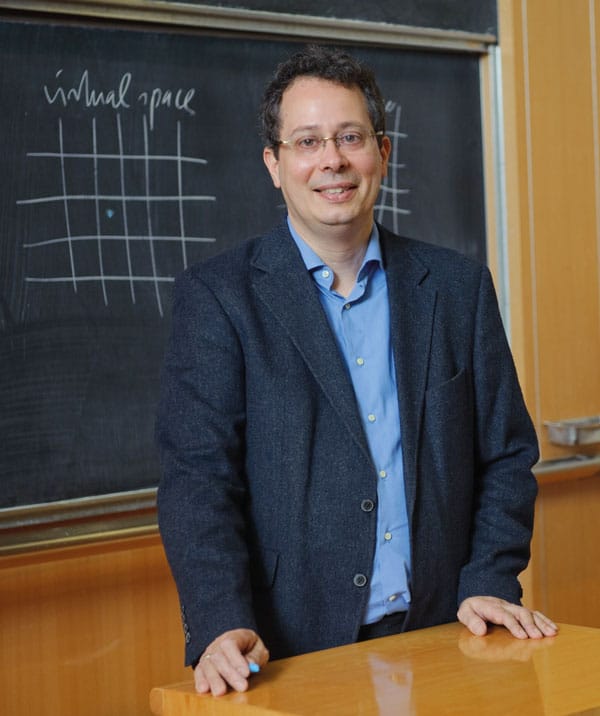This advanced lecture series is part of the Thematic Einstein Semester “Mathematics for Quantum Technologies” (Summer 2024) funded by the Cluster of Excellence MATH+ and the Einstein Foundation Berlin.
Lecturer
Ulf Leonhardt is a professor of physics at the Weizmann Institute of Science, Israel. He is known for his contributions to the theory of metamaterials (invisibility cloaking), quantum electrodynamics in media, optical analogues of black holes, quantum levitation, quantum state tomography, and quantum effects of optical phenomena involving Hawking radiation.
Professor Ulf Leonhardt received the Otto Hahn Medal from the Max Planck Society and the Wolfson Research Merit Award from the Royal Society. In 2006 he received the Scientific American 50 Award forhis work on invisibility phenomena in optics. Ulf Leonhardt has been a member of the Royal Society of Edinburgh since March 2009.

Abstract
The forces of the quantum vacuum appear like an arcane subject, but these forces are all around us, and they do play an increasing role in technology. They are responsible for the capillary forces, without which live would be impossible, and for the van der Waals forces that attract small, electrically neutral particles to each other. These forces arise, because the vacuum – the ground state of quantum fields – is not empty, but full of possibilities. In physics, vacuum fluctuations play the role credit plays in economy: they make things possible by borrowing. For example, an unpolarized molecule may borrow an electromagnetic polarization from the vacuum. Being polarized, it gets attracted to other molecules. After “returning its debt” to the vacuum the molecule is unpolarized again, but the attraction remains.
The course gives a brief, self-consistent introduction into the theory behind the forces of the quantum vacuum. It does not require experience in quantum field theory, but mathematical skills in using complex analysis and conformal mapping for elegant calculations. The goal is to acquire intuition and mathematical procedures for learning how to manipulate vacuum forces in technology.
Registration
Registration is mandatory for participation in the lecture series.
Please register with your institutional e-mail address (announcements will only be forwarded to institutional e-mail addresses).
Schedule
The lecture series comprises four lectures.
- July 15, 2024 (Monday, 10–12 a.m.)
Topic: Setting the sceneQuantization of the electromagnetic field in media and in space-timeNormal modes and harmomic oscillatorsZero-point energyCasimir’s cavity: 1D case, zeta-function renormalizationCasimir’s cavity: 3D case, Casimir’s renormalization
- July 16, 2024 (Tuesday, 10–12 a.m.)
Topic: Lifshitz theoryThe need for a theory in dispersive and dissipative mediaPoint-splitting methodFluctuation-dissipation theoremKubo-Martin-Schwinger relationSolving the Riemann-Hilbert problemMatsubara frequenciesLifshitz formulas for the correlation functionLifshitz renormalization
- July 18, 2024 (Thursday, 10–12 a.m.)
Topic: Applications
Summary of Lifshitz theoryThermal and vacuum fluctuations in empty space (correlations, Stefan-Boltzmann law)Lifshitz formula in planar, piece-wise homogenous mediaImaginary frequencies for capturing the broad band of quantum forcesPerfectly conducting cavityMagnetic mirror and Casimir repulsionPermittivity hierarchy and repulsive Casimir forcesCasimir equilibrium - July 19, 2024 (Friday, 10–12 a.m.)
Topic: Challenges
Experimental inconsistency with Lifshitz theory on thermal forcesThe quantum vacuum as the 21-century etherAccelerated observers (relativistic acceleration, Rindler coordinates, Unruh effect)Observer at rest with the expanding universe (de Sitter space, Gibbons-Hawking effect, cosmological horizons)The enigma of the cosmological constant (“dark energy”) and the case for a Casimir cosmology
The course is based on the book Forces of the Quantum Vacuum: An Introduction to Casimir Physics by William M. R. Simpson and Ulf Leonhardt.

Location
The lectures will be held in Berlin-Mitte. Further details about the location will be communicated only to registered participants via e-mail.
Contact and Further Information
Secretariat: Veronica Bove
Mohrenstraße 39
D–10117 Berlin



